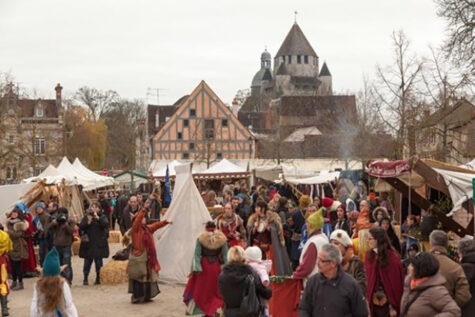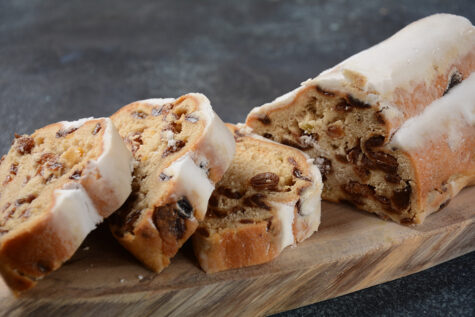Advent was a busy period of festive preparations in the Middle Ages filled with slaughtering, cooking, and brewing
Nowadays, Christmas officially begins after Black Friday, when everybody starts shopping, decorating and celebrating to their heart’s delight. But, as most of the stuff, which goes into the celebration, is bought, the period of preparation, which Christmas formerly called for, can be and has been foreshortened to non-existence
Not so in the Middle Ages, when markets were the primary providers of the fabrics, utensils, and exotic ingredients which could not be produced at home. This means that people in the Middle Ages shopped at Christmas Markets, but only for “things” which were either luxurious, such as spices and foreign fruits (dried raisins and almonds) or handicrafts like toys.
Medieval Markets in Medieval Europe

Although most of the larger Christmas Markets – Bautzen, Frankfurt, Dresden, Augsburg and Nuremberg were first mentioned in the late 14th and 15th centuries, the earliest mention of a dedicated Christmas market seems to be Munich in 1310. From here, it appears the tradition moved west into Alsace, Lorraine and Savoy, together with the tradition of erecting a Christmas tree in the market square in the city.
Around this time – c. 1400 – Nuremberg lists two doll-makers among its burghers. Later in the 16th century, Nuremberg became one of the largest centres for making toys; a position it continues to uphold. Today Nuremberg is home to the world’s largest toy trade exhibition as well as companies carrying the medieval tradition ahead.
Significantly, such markets are known today as Christkindlmarkts, thus tipping their hat to Martin Luther. Unfortunately, only in a few places, the older names have been preserved, such as in Dresden, where the market is called the “Striezelmarkt” (celebrated since 1427). The word Striezel refers to this special cake, the Christstollen.

However, none of its buttery richness defined the original stollen, the earliest reference of which dates to Dresden in 1474. Served during the fasting period of Advent, the stollen was a decidedly unfestive mixture of flour, yeast, water and (perhaps) vegetable oil. At the time, the Catholic church during Advent forbade such non-vegetarian delicacies as butter and eggs. However, Prince Ernest, Elector of Saxony, entreated Pope Innocent VIII to revoke the butter ban. In 1491, the Dukes of Saxony obtained a special permit (the so-called Butterbrief). Bakers were now allowed to add butter and other waist-thickening ingredients to their stollen, for which the customer was obliged to pay a so-called butter tax to the coffers of the Papal Seat in Rome. Also, it was in the Prince’s self-interest to advocate for butter, as a Dresden tradition involved gifting sovereigns with outsized stollen at Christmas time. This tradition hit its apex in 1730 when elector Augustus commissioned a 1.8-ton stollen made by 100 bakers). Hence, the Striezel-Markt. Today the original Chrisstollen is a rich bread cake which has received the EU quality label and is known internationally as the Dresden Stollen. – https://www.dresdnerstollen.com/en/dresdner-christstollen
Today many stollen variations exist. However, the original version, known as Dresdner Christstollen is still prepared according to the original 15th-century recipe, which, according to specialist Hans Röckenwagner, “is mostly fruit held together with a little cake.” Due to successive rising, resting, and ripening periods, the entire stollen process takes four days to prepare — but often fewer to demolish.
We should remember, though, that the idea of mixing fruit into bread dough was a Christmas staple all over Europe, which may still be found in multiple variations (Christmas pudding, Gâteau au fruits de Noël, Panettone, Roscón de Reyes Recipe, Danish Christmas Wreath).
Each of these cakes consists of a sweet pastry made with yeast, plenty of butter and lots of eggs. Into this dough, you mix raisins, candied peels of oranges, chopped almonds, candied ginger or for whatever your tradition calls.
The oldest Christmas Cake
Likely, these breads were bakeries’ products, hence marketed and sold on the local Christmas markets all over Europe. At home, baked goods were less easily made on the open fires of the hearth. One type of goodies, though, seems to have been the ubiquitous practice in medieval households of serving pancakes drizzled in honey and served with dried fruits.
Perhaps inspired by Syrian delicacies imported during the Crusades, they date back to ancient Greece. We even have an original recipe written down by Marcus Porchius Cato, Cato the Elder (234– 149 BC), an influential Roman politician, historian and writer with a successful military career, and known for his major work, De Agri Cultura (On Agriculture). Although not a cookery book at all, it nevertheless has a chapter dedicated to how to make cakes and bread. And one of these recipes describes how to make Globos:
How to Make Globos
Globos sic facito. Caseum eum alica ad eundem modum misceto. Inde quantos voles facere facito. In ahenum caldum unguen indito. Singulos aut binos coquito versatoque crebro duabus rudibus, coctos eximito, eos melle unguito, papaver infriato, ita ponito.
Recipe for globi: Mix the cheese and spelt in the same way, sufficient to make the number desired. Pour lard into a hot copper vessel, and fry one or two at a time, turning them frequently with two rods, and remove when done. Spread with honey, sprinkle with poppyseed, and serve.
(Translation by W. D. Hooper and H. B. Ash, , chapter 79)
Likely, the casein in the recipe was fresh cheese – feta, cottage cheese or just sour milk. Mixed with spelt, cooked in melted lard, and sprinkled with honey and poppyseed, the Globi must have tasted as well as any modern pancake made with sour cream, yoghurt or just buttermilk.
Is it farfetched to imagine that Josef cooked such “globi” over an open fire outside the stable in Bethlehem to nourish the newborn mother? At least, this is what some mothers tell their children serving Chrispels, apple dumplings, pet de nonnes, Krapfen, æbleskiver or whatever they are called at Christmas time.
FEATURED PHOTO:
Medieval Apple Cakes – æbleskiver – in the Danish fashion
Photo 84480402 / Aebleskiver © Ian Walker / Dreamstime.com
